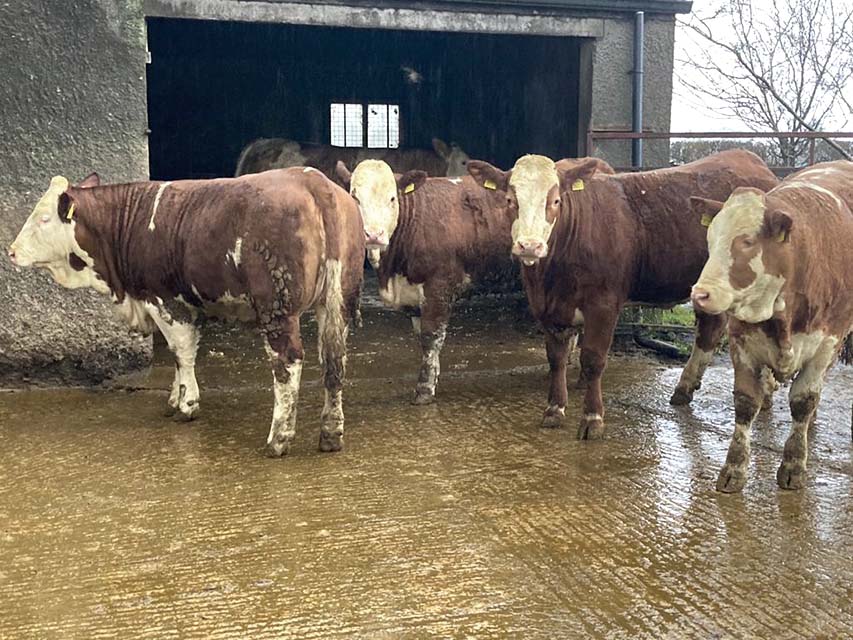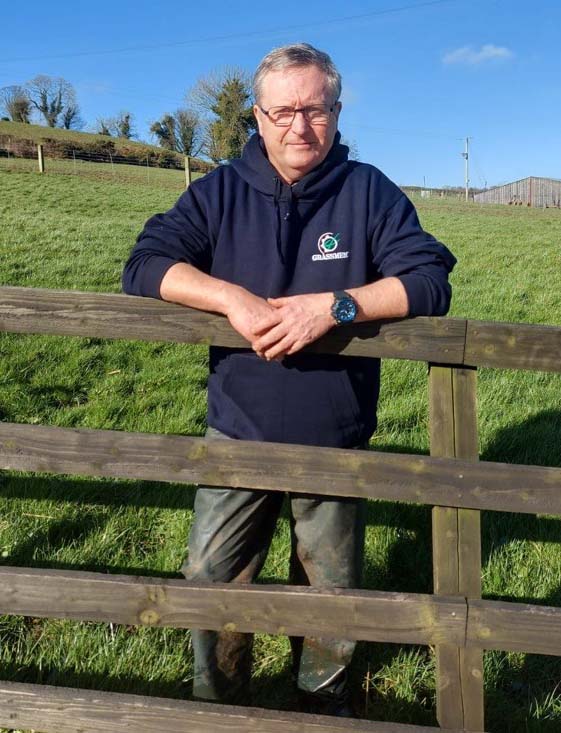Calving system for home bred beef heifers at 2 year old is tried and tested on a County Down farm.
A report on calving from Colin McEvoy, CAFRE Beef & Sheep Development Adviser, County Down.
Cows don’t last forever and will leave the herd for a number of reasons. They may be old, sick or lame. It may be that they did not hold in calf, have poor fertility or poor productivity, or have other undesirable traits such as being aggressive
It is therefore good to a have a clear policy and plan in place to maintain numbers. Suckler herds typically have a replacement rate of 15-30%, on average 20%. As an example a 50 cow herd working with a 20% replacement rate would need 10 replacements every year to sustain itself.

There are two options available; buy in or breed your own.
Whichever option you choose when selecting suckler cow replacements a number of factors need to be considered. What characteristics are you looking for in a sustainable suckler cow? These may include hybrid vigour, milk, calving ability, longevity, size or breed.
An advantage of choosing option one and purchasing replacements is that it can be simple to manage, they can be bought in at a desired age or time and selected according to availablity. However this choice poses a number of disadvantages.
Bio-security can be compromised as you are running the risk of bringing in unwanted diseases. It can be costly and time consuming sourcing them, and you can be limited with availability meaning a lack of control of the genetics sourced.

Breeding your own may be the preferred option. In this instance, it can be advantageous in terms of bio-security; maintaining a closed herd. You also have control over the particular sire genetics and can select on the dam performance history.
On the down side you can have a limited supply of suitable replacements coming on to meet your need. There could be a reduced cash flow as animals are kept within the herd and there could be the need for an additional bull, a maternal bull or AI, resulting in more cash outlay.
One farmer who has been breeding his own replacements and calving them down at 24 months for the last number of years is Ballynahinch Business Development Group (BDG) member and farmer Will Brown.
Will purchased a Simmental bull back in May 2011, which was only sold last summer. This year the tenth crop of potential replacement heifers will be born from this bull.
The bull, Slievenagh Angus, had Estimated Breeding Values (EBVs) positive in Calving Ease Daughters, Maternal Milk and Fat depth. These are all desirable traits from which to breed sustainable replacements in that the bull would produce females that would calve easily, produce good milk yield and have the potential to put fat on their backs so as to keep feed costs down.
The resultant Simmental heifer replacements are then mated to Limousin, Blonde and Charolais bulls for hybrid vigour and extra conformation.
Will is operating a tight spring calving, this means the two options for calving down heifers for the first time are at 2 yr old or 3 yr old. He decided on the 2 yr old option and from his experience he has found these are easier calved than a 3 yr old heifer calving for the first time.
Within the BDG programme, Colin McEvoy, CAFRE’s local Beef & Sheep Development Adviser, organised a BDG meeting on Will’s farm where group members were able to view a selection of offspring from his bull at a variety of stages; maiden/bulling heifers, heifers that calved down at 24 months and cows that subsequently calved at 3, 4 and 5 year old.
He exhibited the animals weights at different ages with the final cow mature weights, illustrating no detrimental effect on mature cow weight as a result of initially calving heifers at 24 months of age.
To achieve 2 year old calving successfully Will aims to meet the following targets annually:
1. Serve heifers at a minimum of 60% of the mature cow weight, for example for a 650 kg cow, aiming to serve at 390kg at 15 months.
2. Calf down at 85% of mature cow weight, for example for a 650kg cow, aiming to calve down at around 550kg at 24 months.
Will commented that good growth performance, especially during the calves’ first winter, is required to meet these targets. Management between 24 months (1st calving) and 36 months (2nd calving) is crucial to ensure the heifer calves again with her second calve at 3 year old.
He focuses on giving his first calving heifers preferential feeding from first calving down to service again, running these heifers as a separate batch from the main herd.
Will added 24 month old calving is more efficient than 3 year old calving.
There is one less batch of heifers to run and therefore the ability to carry more cows on the farm, and the potential to produce additional calves.
If any of the replacements are not as desired there is the option to sell them off before they reach 30 months of age; potentially commanding a higher price of the cull animal.
In conclusion every farm needs a replacement policy in order to maintain numbers. The two options, buy in or breed your own, need to be carefully considered depending on the individual circumstances. Will has demonstrated that breeding on farm is a viable option, keeping a closed herd and affording him the choice of genetics tailored to his requirements.
Calving down his own replacement heifers at 2 year old is proving successful on Will’s farm allowing him to run an efficient suckler cow enterprise.
The Business Development Groups scheme is managed by the College of Agriculture, Food and Rural Enterprise (CAFRE) and is part-funded by the EU through the NI Rural Development Programme 2014-2020.


























